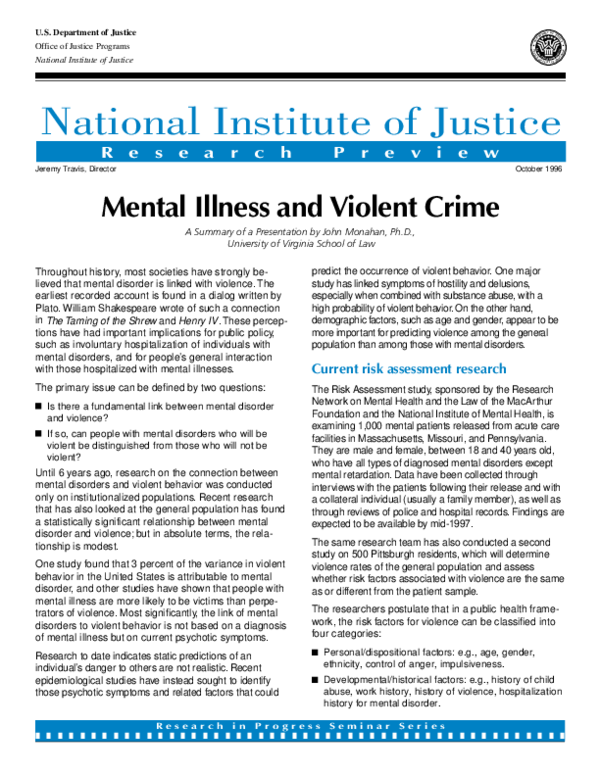Academic Failures In Understanding Mental Illness And Violent Crime

Table of Contents
Oversimplification and Media Portrayal of Mental Illness and Violent Crime
The "Madman" Trope
The media frequently perpetuates the harmful stereotype of the mentally ill individual as a violent threat. This "madman" trope, deeply ingrained in popular culture, fuels public fear and misunderstanding, contributing significantly to the stigma surrounding mental illness.
- Examples of media portrayals: Many films and television shows depict individuals with mental illness as unpredictable and prone to violence, often without any nuanced portrayal of their condition. News reports frequently emphasize the mental health status of perpetrators in violent crimes, even when there's no clear causal link.
- Impact on public perception: This constant exposure to negative stereotypes leads to fear, prejudice, and discrimination against individuals with mental illnesses. It makes it harder for individuals to seek help, further exacerbating the problem.
- Perpetuation of harmful stereotypes: The media's role in reinforcing these inaccurate associations cannot be overstated. It's crucial for journalists and filmmakers to portray mental illness responsibly and accurately, avoiding sensationalism and harmful generalizations.
Ignoring Nuance and Complexity
The relationship between mental illness and violence is not straightforward. There's a vast spectrum of mental illnesses, each with varying levels of risk associated with violent behavior. Academic research often fails to acknowledge this crucial nuance.
- Examples of mental illnesses: Schizophrenia, bipolar disorder, and major depressive disorder are just a few examples, each with a unique presentation and varying levels of risk factors.
- Different risk factors: Violence is rarely solely caused by mental illness. Other factors like substance abuse, childhood trauma, social isolation, and access to weapons also play a significant role. Individual risk assessments are crucial to understand the complex interplay.
- Importance of individual assessment: Generalizations about entire diagnostic categories are dangerous. Each individual's case must be considered uniquely, factoring in their specific circumstances and the complex interplay of risk and protective factors. The absence of such individualized consideration is a significant failure in our academic approach to mental illness and violent crime.
Methodological Flaws in Research on Mental Illness and Violent Crime
Sampling Biases and Generalizations
Much of the existing research on mental illness and violent crime relies on biased sampling techniques, primarily focusing on forensic populations (individuals involved in the criminal justice system). This approach leads to inaccurate generalizations about the general population with mental illness.
- Examples of biased sampling techniques: Over-reliance on individuals in psychiatric hospitals or prisons creates a skewed sample, as these populations are not representative of individuals with mental illness in the broader community.
- Limitations of generalizing findings: Findings from these biased samples cannot be accurately applied to the general population, leading to inflated perceptions of the link between mental illness and violence.
- Importance of representative samples: Future research must utilize representative samples to accurately reflect the prevalence of violence among individuals with mental illness in the general population. This will require more community-based studies with better access to diverse participants.
Causation vs. Correlation
Many studies mistakenly conflate correlation with causation. Just because two factors are associated doesn't mean one causes the other. This is a significant methodological flaw in much of the research on mental illness and violent crime.
- Examples of confounding variables: Substance abuse, childhood trauma, and socioeconomic disadvantage are often confounding variables that significantly impact both mental health and the likelihood of violent behavior. Ignoring these factors leads to inaccurate conclusions.
- Limitations of correlational studies: Correlational studies, while valuable, cannot establish causality. Longitudinal studies and more sophisticated statistical methods are needed to determine true causal relationships.
- Need for advanced research methodologies: Addressing this requires a shift toward more robust research designs, including longitudinal studies that follow individuals over time to understand the development of mental illness and violent behavior, and sophisticated statistical analysis to control for confounding factors.
Academic Neglect of Protective Factors and Successful Interventions
Focus on Risk Factors Only
Research often disproportionately focuses on risk factors for violence, neglecting the crucial role of protective factors that can mitigate the risk. This unbalanced approach reinforces negative stereotypes and hinders the development of effective prevention strategies.
- Examples of protective factors: Strong social support networks, access to quality mental healthcare, early intervention programs, and stable housing are examples of protective factors that can significantly reduce the risk of violence.
- Importance of a balanced perspective: Understanding both risk and protective factors is crucial for developing comprehensive and effective strategies for preventing violence. A balanced approach allows for a more holistic and nuanced understanding of the interplay of factors influencing violent behavior.
- Addressing systemic issues: Recognizing and actively addressing systemic issues such as poverty, lack of access to healthcare and education, and social injustice are crucial for fostering protective environments.
Insufficient Research on Effective Treatments and Interventions
There's a significant lack of research on evidence-based treatments and interventions for preventing violence among individuals with mental illness. This is a critical gap in our understanding and limits the effectiveness of our prevention and intervention efforts.
- Examples of effective treatments: Medication, psychotherapy (including cognitive behavioral therapy), and case management are examples of evidence-based interventions that can improve mental health outcomes and reduce the risk of violence.
- Need for more research on long-term outcomes: More research is needed to understand the long-term effectiveness of different interventions and to identify which strategies are most effective for different populations and specific mental illnesses.
- Promoting access to quality mental healthcare: Increasing funding for mental healthcare research and ensuring access to high-quality care is crucial to improve outcomes and reduce violence. This includes early intervention services to address issues before they escalate.
Conclusion
Academic research and popular understanding frequently oversimplify the complex relationship between mental illness and violent crime, fostering harmful stereotypes and ineffective policies. This article has highlighted the need for more rigorous, nuanced research that considers a wider range of factors, including both risk and protective factors. Promoting mental health awareness and ensuring access to quality care are vital steps in reducing violence and improving outcomes for individuals with mental illness. We need to move beyond simplistic narratives and embrace a comprehensive understanding of the contributing factors, focusing on prevention and effective interventions. We must critically evaluate information about mental illness and violent crime, support research initiatives, and advocate for policies that address the root causes of violence while providing effective support for individuals struggling with mental illness. The accurate and nuanced understanding of the relationship between mental illness and violent crime is crucial for creating a safer and more equitable society.

Featured Posts
-
 Dakota Johnsons Figure Hugging Dress A Red Carpet Highlight
May 09, 2025
Dakota Johnsons Figure Hugging Dress A Red Carpet Highlight
May 09, 2025 -
 Family Support For Dakota Johnson At Materialist Los Angeles Premiere
May 09, 2025
Family Support For Dakota Johnson At Materialist Los Angeles Premiere
May 09, 2025 -
 The Harry Styles Benson Boone Controversy A Look At The Accusations Of Plagiarism
May 09, 2025
The Harry Styles Benson Boone Controversy A Look At The Accusations Of Plagiarism
May 09, 2025 -
 Madeleine Mc Cann Investigation A 23 Year Olds Dna Test Results
May 09, 2025
Madeleine Mc Cann Investigation A 23 Year Olds Dna Test Results
May 09, 2025 -
 Blue Origin Rocket Launch Cancelled Subsystem Issue
May 09, 2025
Blue Origin Rocket Launch Cancelled Subsystem Issue
May 09, 2025
